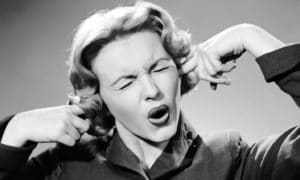If only there was something I could have done about my hearing loss…
Preventing Hearing Loss
Do you remember as a kid not being able to eat your dessert until you finished all of your vegetables? Although you may not have realized it then, this was your parents’ attempt to prevent you from adopting unhealthy eating habits in your later years. Just like with unhealthy eating, you can also implement good techniques for preventing hearing loss in your later years; particularly, when it comes to noise-induced hearing loss (NIHL). NIHL is acquired from being in environments where there is loud noise. Sometimes the loud noise is constant and continuous; sometimes it is extremely loud for short durations of time. Either may cause damage to your hearing and result in hearing loss.
you finished all of your vegetables? Although you may not have realized it then, this was your parents’ attempt to prevent you from adopting unhealthy eating habits in your later years. Just like with unhealthy eating, you can also implement good techniques for preventing hearing loss in your later years; particularly, when it comes to noise-induced hearing loss (NIHL). NIHL is acquired from being in environments where there is loud noise. Sometimes the loud noise is constant and continuous; sometimes it is extremely loud for short durations of time. Either may cause damage to your hearing and result in hearing loss.
Approximately 26 million American adults reported having hearing loss due to recreational or occupational noise exposure. 10 million cases have been directly linked to noise exposure. This proves that NIHL is a serious condition. However, NIHL is 100% preventable. You should always wear hearing protection when performing loud activities to greatly reduce your chances for acquiring NIHL.
Occupational Noise Exposure
If you work in an industrial work environment, you may be exposed to very loud levels of noise. Machines and equipment often used in industrial occupational settings may generate noise levels over 100 dB causing workers to be exposed to these levels for 8 hours or longer. For this reason, hearing conservation programs have been implemented into industrial settings where workers are exposed to noise levels of 85 dB or more over an 8 hour period. Federal and state mandated hearing conservation programs have helped to reduce the amount of noise exposure in occupational settings, thus reducing the risk for NIHL.
Non-occupational Noise Exposure
Your recreational activities may also damage your hearing. Activities such as target shooting, hunting, snowmobile, explosives or firecrackers, concerts, high volume head phones and personal audio players, and cap guns have the potential to produce noise levels that are quite hazardous to your hearing (National Institute on Deafness and Communications Disorders).
Activities you perform at home may also be hazardous. Activities such as mowing the lawn, wood working, and using the leaf blower may produce noise levels that are quite excessive and potentially damaging to your hearing.
Intensities of Common Sounds in Decibels:
| Source of Noise | Decibel Level (dB) |
| Humming of a refrigerator | 45 dB |
| Normal conversation | 60 dB |
| Noise from heavy traffic | 85 dB |
| Motorcycles | 95 dB |
| An MP3 player at maximum volume | 105 dB |
| Rock concert | 110 dB |
| Sirens | 120 dB |
| Firecrackers and firearms | 150 dB |
Hearing Protection
Proper hearing protection may decrease your risk for acquiring NIHL. You may choose to wear earplugs or earmuffs to protect your hearing during very noisy activities. Each type of hearing protection will have a noise reduction rating (NRR). Check the NRR to see exactly how much the noise will be reduced by wearing each type of hearing protection.
Custom hearing protection is also available for hunters, shooters, musicians, law enforcement, and industrial workers. Consult with us at 907-789-6780 to find the best hearing protection to suit your needs.
Protect your hearing now so that you won’t have to pay for it later. Call us now at 907.789.6780 to schedule an appointment!
